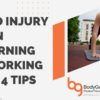[et_pb_section fb_built=”1″ _builder_version=”3.0.47″][et_pb_row _builder_version=”3.0.47″ background_size=”initial” background_position=”top_left” background_repeat=”repeat”][et_pb_column type=”4_4″ _builder_version=”3.0.47″ parallax=”off” parallax_method=”on”][et_pb_text _builder_version=”3.0.47″ background_size=”initial” background_position=”top_left” background_repeat=”repeat”]
Authored by: Meghan Simonetti-Deters, PT, DPT, MSHA, FMS-cert
The Chicago Marathon is just around the corner and WE want to help YOU perform at your optimum level!

The 3 Basic Reference Planes used in Anatomy
Our Body Gears Physical Therapists utilize “Core First Strategies” when we treat our patients – this is a thought process that extrapolates the idea that if your alignment is right and if your core INITIATES during every movement, you will be more efficient. Efficiency is KEY in marathon running – you cannot afford to waste any amount of energy.
What muscles work the hardest?
If I ask you, “what muscles work the hardest when you are running a marathon?” what muscle groups come to mind? Gluteals, quadriceps, hamstrings, and soleus/gastrocnemius should come to mind – but we cannot forget about the mighty core! Our abdominal muscles, specifically our transversus abdominus and oblique internus and externus must be involved while we are running, especially long distances. A light contraction of our abdominal muscles while running can help us stay in the sagittal plane, moving forward, opposed to moving in the transverse plane, too much twisting! Below are 3 simple Core First self-assessments you can use during these last few weeks of training to make sure you are as efficient as possible!
Be vain – look in the mirror during your runs to check out your alignment.
Believe it or not, but when you are running, your torso should be slightly tilted anteriorly – or forward. I like to think of the alignment of a ski jumper – that beautiful straight line on a 30-45 degree angle. THIS is the alignment your torso should have. The almost falling forward creating a reflex of your legs to “catch” you creating that smooth running pattern.
If you are running with your torso too upright it can lead to increased muscular activation trying to propel you forward in the transverse plane, not the sagittal plane. The transverse plane is more like a hip swivel – your body is trying to move forward by twisting at the hips like a power walker. The straight but forward lean of your torso allows you to stay in that sagittal plane. Another negative attribute of running too upright is increased lumbar lordosis – or low back extension. This leads to an inability to effectively contract your core muscles further leading to more energy requirement from your legs.
Be efficient and keep your alignment! Check yourself out in a nearby window reflection or reflection off the water during your run. You aren’t being vain, you are making sure you have the best alignment!
Check out your shoes – where is your shoe the most worn down? Is it on the heel? More on the outside or inside of the heel?
Where your shoe is the most worn down is likely where your foot first strikes the ground during running. If that wear pattern is closer to your heel, it is likely you don’t have the best alignment during your run. Heel striking could indicate you have too much lumbar lordosis, or too much low back extension when you are running. If your low back is extended, then your core muscles in the front are relatively stretched making it harder to turn them on. Heel striking also increases muscular demand on your ankle dorsiflexors and plantar flexors – your calf and shin muscles. You need those muscles to get you through the entire marathon, so don’t over work them early in your race!
So look at your shoes and see if your postural alignment is affecting your foot strike.
Analyze Your Arm Swing
When we run, there is a reciprocal relationship between our pelvis and our scapula, or shoulder blade. This is why when we walk and run our opposite arm and leg swing together. When running, your arm swing should not be extreme, the phrase “hip to nip” is a common rule to abide by. Your wrist should never swing below your hip or above your nipple when running. If your arm swing is too dramatic, it indicates increased transverse plane mobility. Your obliques are likely working too hard to swing your pelvis forward, creating reciprocation to the opposite shoulder blade. Instead of swinging your pelvis forward, your deep core muscles should be LIFTING your femur forward to clear the ground and propel forward.
BONUS!
Check out this simple exercise that helps activate your core to complete BEFORE you run!


Every year, we support Team Imerman Angels and their mission to provide personalized connections that enable one-on-one support among cancer fighters, survivors, and caregivers! Find out more about this amazing group and how to get involved here.
Imerman Angels Website Follow Socially @ImermanAngels
Get your Pre and Post Marathon Assessment by Scheduling a Complimentary Screen Now
[/et_pb_text][/et_pb_column][/et_pb_row][/et_pb_section]






